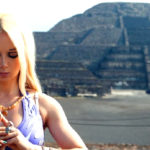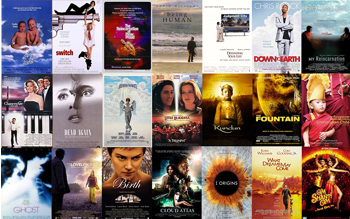Part I: Blame It On Plato In the Western world, an afterlife belief in the concept of “general reincarnation” has been steadily on the rise and gaining ground.
The concept of “general reincarnation” is the belief that everyone and every living thing repeatedly “reincarnates” (i.e. lives more than one life on this physical plane) in order to learn lessons and spiritually evolve.
Many naturally assume this growing Western world belief in reincarnation is primarily based on a simultaneous increasing influence of Eastern religion and thought. This assumption is due, in part, to much of the Eastern religious world having long adhered to a belief in general reincarnation.
However, notwithstanding recurring allusions to the Eastern concept of karma and reincarnation by New Age thinkers – our extraverted Western attitude toward death and the afterlife experiences great angst when encountering the Eastern religious concept of the annihilation of the ego and/or individual personality after death.
Paying close attention, the current Western World “rebirth” of a belief in reincarnation (pun intended) owes much or most of the credit to the ancient classical Greeks and their fascinating views on the afterlife and reincarnation.
In particular, we owe many of our ideas to the musings and discourses of the ancient classical Greek philosopher Plato (428/427 BC – 348/347 BC).
Plato and The Republic The fact is that we, in the Western world, feel much more at home and comfortable with the metaphysical philosophies of the ancient Greeks and specifically with those of Plato.
One of the best peeks into the cosmological views of Plato and reincarnation is contained in the final chapter of The Republic and the “Myth of Er.”
Believe it or not, if you’re a Westerner that believes in general reincarnation, then much of what Plato had to say on the matter in The Republic will resonate as being quite familiar.
Greatly oversimplifying, ancient classical Greek views of the afterlife were generally a hazy amalgamation of “heaven and hell” combined with reincarnation. Keeping things simple, I’ll be sticking with Plato’s stated views on reincarnation and leaving out the “heaven and hell” part.
Part II: So What Does Plato Say According to Plato’s account in The Republic, in preparation for reincarnation, each person chooses a daemon or deity that will guide him or her through life.
According to Greek thought in Plato’s day, this guiding daemon accompanied most people throughout their life as an unconscious guiding force. It was generally held that only a select few advanced souls, such as the philosopher Socrates, were capable of actually conversing and/or interacting with their guiding daemon.
As the story goes… upon choosing a daemon or deity, each person was then led to the spinning wheel or spindle of the Greek goddess, Necessity. The spinning wheel was sitting in the lap of Necessity.
This is where it tends to get really interesting for those of us that are astrology buffs…
Spinning Wheel of Necessity According to Plato, the spinning wheel or spindle of Necessity was comprised of one outer wheel (the Zodiac) and then seven inner wheels (the Sun, the Moon, and the five known planets).
In Greek mythology and tradition, the goddess Necessity had three daughters: Lachesis, Clotho, and Atropos. The three sisters were together known as the Fates. Lachesis (meaning: she who allots) measured the thread of fate, Clotho (meaning: weaver) wove the thread of fate, and Atropos (meaning: implacable, unbending, unyielding) cut the thread of fate.
Lachesis (meaning: she who allots) measured the thread of fate Clotho (meaning: weaver) wove the thread of fate Atropos (meaning: implacable, unbending, unyielding) cut the thread of fate In Plato’s cosmological mythology, he identifies Lachesis as having her hands busy with both the zodiacal signs and the planets, Clotho with the zodiacal signs and Atropos with the planets. Also, of interest, Lachesis is singing of the past, Clotho is singing of the present, and Atropos is singing of the future. Each soul approaches Lachesis first, then Clotho, and then finally Atropos.
Lachesis: measured the thread (zodiacal signs and the planets) – past Clotho: wove the thread (zodiacal signs) – present Atropos: cut the thread (the planets) – future At this point, I think I’ll let Plato speak for himself:
“When the souls had all finished choosing their lives, they approached Lachesis in the order the lottery had assigned them. She gave each of them the personal deity they’d selected to accompany them throughout their lives, as their guardians and to fulfill the choices they had made. Each deity first led its soul to Clotho (zodiacal signs), to pass under her hand and under the revolving orbit of the spindle, and so to ratify the destiny the soul had chosen in the lottery.
Then, once a connection has been made with her, the deity led the soul to Atropos (planets) and her spinning, to make the web woven by Clotho fixed and unalterable. Afterwards, the soul set a fixed course for Lady Necessity’s throne and passed under it…” Plato, the Republic translation by Robin Waterfield (620e) (Italics for emphasis and the words contained within parentheses are mine.)
So what in the heck does all this mean? Glad you asked…
Part III: Destiny and the Zodiac In Robin Waterfield’s translation of The Republic, Waterfield points to what are clear astrological referrals in this poignant quoted passage on reincarnation:
“When the souls had all finished choosing their lives, they approached Lachesis in the order the lottery had assigned them. She gave each of them the personal deity they’d selected to accompany them throughout their lives, as their guardians and to fulfill the choices they had made. Each deity first led its soul to Clotho (zodiacal signs), to pass under her hand and under the revolving orbit of the spindle, and so to ratify the destiny the soul had chosen in the lottery.
Then, once a connection has been made with her, the deity led the soul to Atropos (planets) and her spinning, to make the web woven by Clotho fixed and unalterable. Afterwards, the soul set a fixed course for Lady Necessity’s throne and passed under it…” Plato, The Republic translation by Robin Waterfield (620e) (Italics for emphasis and the words contained within parentheses are mine.)
Ratify, Destiny, and Astrology Here’s where it comes in really, really handy to read and pay attention to translation notes…
According to Robin Waterfield, the word “ratify” was associated with the ruling of a planet. The word used for “destiny” meant (or later came to mean) “degree on the zodiacal circle.”
i.e. The ruling planet ratified [approved, sanctioned, authorized] the degree on the zodiacal circle. The guiding daemon or deity was assigned to this particular degree on the zodiacal circle.
As for the uncomfortable word, “unalterable,” Waterfield points out that in Plato’s other writings, he (Plato) leaves room for change in each person’s individual life.
“It is only the broad framework which is fixed… The whole of Plato’s philosophy leaves room for self-improvement within that framework.”
River of Neglect Continuing on with Plato’s myth, all the souls then traveled to the Plain of Oblivion, located next to the River of Neglect. Each soul was required to drink a certain portion of the water, that would cause them to forget his or her past life – but apparently some of the people unwisely drank more of the water than they had to.
(Didn’t I tell you that much of Plato’s account would likely sound familiar?)
I won’t get into the fact that Plato, likewise, believed a man that had made less than wise decisions in his life would likely be required to take a “step down” and be reincarnated as a woman or an animal.
Which Point On the Astrological Chart? In case you’re wondering, the possibility of setting a steadfast rule – as to which zodiacal degree on the horoscopic chart represents the guiding daemon or deity – appears to be a pointless, endless exercise in speculation and futility.
It’s impossible to now definitively know what (if anything) might have been on Plato’s mind.
In ancient Greek astrology, the “horoskopos” literally meant “look to the hour [of birth].” The zodiacal sign of the Ascendant, followed closely by the zodiacal sign on the Midheaven, were considered to be of the greatest import.
Looking at all this through relatively modern eyes, the most likely suspects are therefore (primarily) the birth chart’s Ascendant and its planetary ruler, (secondarily) the Midheaven and its planetary ruler, and/or (thirdly) any planets that might be located on the Ascendant or Midheaven.
However, each and every horoskopic chart contains several potential guiding myths for an individual.
Ultimately, the jury will (and should) have to stay out on this one. Old world philosophers and thinkers were generally quite comfortable with the possibility of having wonderful, thought provoking, ineffable, tenuous mysteries with no one, single, absolute solution or resolution.
That manner of thinking is obviously extremely challenging for us – with our modern day (supposed) sensibilities and proclivities – to fully wrap our minds around.
My Own Views As for my own views on the objective reality of reincarnation – parroting my mentor, CG Jung (parroting Gautama Buddha) – I prefer keeping the question of reincarnation open, without passing judgment on the matter.
Quoting St. Paul: “We know only in part, and we prophesy only in part;… for now we “see through a mirror, dimly.”
Suggestion? All metaphsyical, religious, spiritual theories should start with: “It’s as if… “








